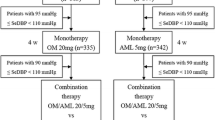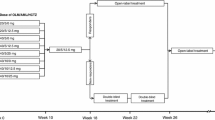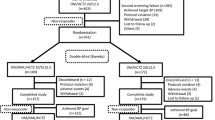Abstract
Background and objective: Hypertension remains a major global health problem, and evidence suggests that the majority of patients will require two or more antihypertensive agents in order to reach specified BP targets. Combining two drugs from different classes has the potential to target different aspects of hypertension, which may result in additional BP decreases compared with either agent used alone. This randomized, double-blind, parallel-group, multicentre trial in patients with moderate-to-severe hypertension (systolic BP [SBP]/diastolic BP [DBP] ≥ 160/100 mmHg) investigated the additional efficacy in BP reduction and BP goal rates (< 140/90 mmHg for patients without diabetes mellitus, < 130/80 mmHg for patients with diabetes) achieved by adding amlodipine 5 or 10mg/day to olmesartan medoxomil (hereafter olmesartan) 20mg/day in patients not adequately controlled on olmesartan monotherapy.
Methods: After 8 weeks’ open-label olmesartan 20 mg monotherapy, 538 patients with SBP/DBP ≥140/90mmHg were randomized to 8 weeks’ double-blind therapy with olmesartan/placebo, olmesartan/amlodipine 20mg/5mg or olmesartan/amlodipine 20mg/10mg. This trial is registered on the http://www.clinicaltrials.govwebsite (NCT00220220).
Results: After 8 weeks (with last observation carried forward), the adjusted mean change in seated DBP (SeDBP) from baseline was −7.6 mmHg for olmesartan/placebo, −10.4mmHg for olmesartan/amlodipine 20mg/5mg (p=0.0006 vs olmesartan/placebo) and −10.9 mmHg for olmesartan/amlodipine 20mg/10mg (p < 0.0001 vs olmesartan/placebo). Mean changes in SeSBP from baseline with olmesartan/amlodipine 20mg/5mg and olmesartan/amlodipine 20mg/10mg were −16.1 and −16.7 mmHg, respectively (p < 0.0001 for both dose regimens vs olmesartan/placebo). BP goal rates were significantly higher with olmesartan/amlodipine 20mg/5mg and olmesartan/amlodipine 20mg/10mg (44.5% and 45.8%, respectively; p=0.0011 and p=0.0004, respectively) versus olmesartan/placebo (28.5%). Combination therapy was well tolerated, and the incidence of drug-related adverse events was 8.9% for olmesartan/placebo, 7.7% for olmesartan/amlodipine 20mg/5mg, and 11.3% for olmesartan/amlodipine 20 mg/10 mg (p=0.490). Most adverse events were mild in severity and were well known drug-class issues.
Conclusion: Combining olmesartan and amlodipine resulted in significantly greater BP lowering in patients not achieving adequate BP control with olmesartan monotherapy, thus allowing a significantly greater proportion of patients to achieve BP goal.





Similar content being viewed by others
References
Ong KL, Cheung BM, Man YB, et al. Prevalence, awareness, treatment, and control of hypertension among United States adults 1999–2004. Hypertension 2007 Jan; 49(1): 69–75
Wolf-Maier K, Cooper RS, Kramer H, et al. Hypertension treatment and control in five European countries, Canada, and the United States. Hypertension 2004 Jan; 43(1): 10–7
Lewington S, Clarke R, Qizilbash N, et al. Age-specific relevance of usual blood pressure to vascular mortality: a meta-analysis of individual data for one million adults in 61 prospective studies. Lancet 2002 Dec 14; 360(9349): 1903–13
Mancia G, De Backer G, Dominiczak A, et al. 2007 guidelines for the management of arterial hypertension: the Task Force for the Management of Arterial Hypertension of the European Society of Hypertension (ESH) and of the European Society of Cardiology (ESC). J Hypertens 2007 Jun; 25(6): 1105–87
Turnbull F. Effects of different blood-pressure-lowering regimens on major cardiovascular events: results of prospectively-designed overviews of randomised trials. Lancet 2003 Nov 8; 362(9395): 1527–35
Hansson L, Zanchetti A, Carruthers SG, et al. Effects of intensive blood-pressure lowering and low-dose aspirin in patients with hypertension: principal results of the Hypertension Optimal Treatment (HOT) randomised trial. HOT Study Group. Lancet 1998 Jun 13; 351(9118): 1755–62
Whitworth JA. 2003 World Health Organization (WHO)/International Society of Hypertension (ISH) statement on management of hypertension. J Hypertens 2003 Nov; 21(11): 1983–92
Cushman WC, Ford CE, Cutler JA, et al. Success and predictors of blood pressure control in diverse North American settings: the Antihypertensive and Lipid-Lowering treatment to prevent Heart Attack Trial (ALLHAT). J Clin Hypertens (Greenwich) 2002 Nov–Dec; 4(6): 393–404
Dahlof B, Devereux RB, Kjeldsen SE, et al. Cardiovascular morbidity and mortality in the Losartan Intervention For Endpoint reduction in hypertension study (LIFE): a randomised trial against atenolol. Lancet 2002 Mar 23; 359(9311): 995–1003
Chobanian AV, Bakris GL, Black HR, et al. The seventh report of the Joint National Committee on Prevention, Detection, Evaluation, and Treatment of High Blood Pressure: the JNC 7 report. JAMA 2003 May 21; 289(19): 2560–72
Barrios V, Banegas JR, Ruilope LM, et al. Evolution of blood pressure control in Spain. J Hypertens 2007 Sep; 25(9): 1975–7
Barrios V, Escobar C, Calderon A, et al. Blood pressure and lipid goal attainment in the hypertensive population in the primary care setting in Spain. J Clin Hypertens (Greenwich) 2007 May; 9(5): 324–9
Wang YR, Alexander GC, Stafford RS. Outpatient hypertension treatment, treatment intensification, and control in Western Europe and the United States. Arch Intern Med 2007 Jan 22; 167(2): 141–7
Neutel JM. Low-dose antihypertensive combination therapy: its rationale and role in cardiovascular risk management. Am J Hypertens 1999 Aug; 12 (8 Pt 2): 73S–9S
Law MR, Wald NJ, Morris JK, et al. Value of low dose combination treatment with blood pressure lowering drugs: analysis of 354 randomised trials. BMJ 2003 Jun 28; 326(7404): 1427–31
Frishman WH, Ram CV, McMahon FG, et al. Comparison of amlodipine and benazepril monotherapy to amlodipine plus benazepril in patients with systemic hypertension: a randomized, double-blind, placebo-controlled, parallel-group study. The Benazepril/Amlodipine Study Group. J Clin Pharmacol 1995 Nov; 35(11): 1060–6
Kuschnir E, Acuna E, Sevilla D, et al. Treatment of patients with essential hypertension: amlodipine 5 mg/benazepril 20 mg compared with amlodipine 5 mg, benazepril 20 mg, and placebo. Clin Ther 1996 Nov–Dec; 18(6): 1213–24
Jamerson K, Weber MA, Bakris GL, et al. Benazepril plus amlodipine or hydrochlorothiazide for hypertension in high-risk patients. N Engl J Med 2008 Dec 4; 359(23): 2417–28
Abernethy DR. The pharmacokinetic profile of amlodipine. Am Heart J 1989 Nov; 118 (5 Pt 2): 1100–3
Brunner HR, Laeis P. Clinical efficacy of olmesartan medoxomil. J Hypertens Suppl. 2003 May; 21(2): S43–6
Giles TD, Oparil S, Silfani TN, et al. Comparison of increasing doses of olmesartan medoxomil, losartan potassium, and valsartan in patients with essential hypertension. J Clin Hypertens (Greenwich) 2007 Mar; 9(3): 187–95
Smith DH, Dubiel R, Jones M. Use of 24-hour ambulatory blood pressure monitoring to assess antihypertensive efficacy: a comparison of olmesartan medoxomil, losartan potassium, valsartan, and irbesartan. Am J Cardiovasc Drugs 2005; 5(1): 41–50
Barrios V, Escobar C. Olmesartan medoxomil plus hydrochlorothiazide for treating hypertension. Expert Opin Pharmacother 2008 Jan; 9(1): 129–36
Chrysant SG, Weber MA, Wang AC, et al. Evaluation of antihypertensive therapy with the combination of olmesartan medoxomil and hydrochlorothiazide. Am J Hypertens 2004 Mar; 17(3): 252–9
Greathouse M. Olmesartan medoxomil combined with hydrochlorothiazide for the treatment of hypertension. Vasc Health Risk Manag 2006; 2(4): 401–9
Philipp T, Smith TR, Glazer R, et al. Two multicenter, 8-week, randomized, double-blind, placebo-controlled, parallel-group studies evaluating the efficacy and tolerability of amlodipine and valsartan in combination and as monotherapy in adult patients with mild to moderate essential hypertension. Clin Ther 2007 Apr; 29(4): 563–80
Poldermans D, Glazes R, Kargiannis S, et al. Tolerability and blood pressure-lowering efficacy of the combination of amlodipine plus valsartan compared with lisinopril plus hydrochlorothiazide in adult patients with stage 2 hypertension. Clin Ther 2007 Feb; 29(2): 279–89
Basile JN, Chrysant S. The importance of early antihypertensive efficacy: the role of angiotensin II receptor blocker therapy. J Hum Hypertens 2006 Mar; 20(3): 169–75
Preston RA, Materson BJ, Reda DJ, et al. Placebo-associated blood pressure response and adverse effects in the treatment of hypertension: observations from a Department of Veterans Affairs Cooperative Study. Arch Intern Med 2000 May 22; 160(10): 1449–54
Chrysant SG, Bakris GL. Amlodipine/benazepril combination therapy for hypertensive patients nonresponsive to benazepril monotherapy. Am J Hypertens 2004 Jul; 17(7): 590–6
Lacourciere Y, Tytus R, O’Keefe D, et al. Efficacy and tolerability of a fixed-dose combination of telmisartan plus hydrochlorothiazide in patients uncontrolled with telmisartan monotherapy. J Hum Hypertens 2001 Nov; 15(11): 763–70
Barrios V, Boccanelli A, Ewald S, et al. Efficacy and tolerability of olmesartan medoxomil in patients with mild to moderate essential hypertension: the OLMEBEST Study. Clin Drug Invest 2007; 27(8): 545–58
Julius S, Kjeldsen SE, Weber M, et al. Outcomes in hypertensive patients at high cardiovascular risk treated with regimens based on valsartan or amlodipine: the VALUE randomised trial. Lancet 2004 Jun 19; 363(9426): 2022–31
Allemann Y, Fraile B, Lambert M, et al. Efficacy of the combination of amlodipine and valsartan in patients with hypertension uncontrolled with previous monotherapy: the Exforge in Failure After Single Therapy (EX-FAST) study. J Clin Hypertens 2008; 10: 185–94
Chrysant S, Melino M, et al. A factorial study evaluating the efficacy and safety of combination of olmesartan medoxomil and amlodipine besylate in controlling high blood pressure (COACH). Clin Ther 2008; 30(4): 587–604
de la Sierra A. Mitigation of calcium channel blocker-related oedema in hypertension by antagonists of the reninangiotensin system. J Hum Hypertens 2009 Jan 15. Epub
Barrios V, Escobar C, Calderon A, et al. Cardiovascular risk profile and risk stratification of the hypertensive population attended by general practitioners and specialists in Spain. The CONTROLRISK study. J Hum Hypertens 2007 Jun; 21(6): 479–85
Fliser D, Buchholz K, Haller H. Antiinflammatory effects of angiotensin II subtype 1 receptor blockade in hypertensive patients with microinflammation. Circulation 2004 Aug 31; 110(9): 1103–7
Smith RD, Yokoyama H, Averill DB, et al. Reversal of vascular hypertrophy in hypertensive patients through blockade of angiotensin II receptors. J Am Soc Hypertens 2008; 2(3): 165–72
Stumpe KO, Agabiti-Rosei E, Zielinski T, et al. Carotid intima-media thickness and plaque volume changes following 2-year angiotensin II-receptor blockade: the Multicentre Olmesartan atherosclerosis Regression Evaluation (MORE) study. Ther Adv Cardiovasc Dis 2007; 1: 97–106
Pitt B, Byington RP, Furberg CD, et al. Effect of amlodipine on the progression of atherosclerosis and the occurrence of clinical events: PREVENT Investigators. Circulation 2000 Sep 26; 102(13): 1503–10
Terpstra WF, May JF, Smit AJ, et al. Effects of amlodipine and lisinopril on intima-media thickness in previously untreated, elderly hypertensive patients (the ELVERA trial). J Hypertens 2004 Jul; 22(7): 1309–16
Aslam S, Santha T, Leone A, et al. Effects of amlodipine and valsartan on oxidative stress and plasma methylarginines in end-stage renal disease patients on hemodialysis. Kidney Int 2006 Dec; 70(12): 2109–15
Hasegawa H, Takano H, Kohro T, et al. Amelioration of hypertensive heart failure by amlodipine may occur via antioxidative effects. Hypertens Res 2006 Sep; 29(9): 719–29
Acknowledgements
This study (including provision of study drug) was sponsored by Daiichi-Sankyo Europe GmbH, Munich, Germany. Medical writing support was provided to the authors by Anne-Marie Stephani from Wolters Kluwer Health Medical Communications, on behalf of Daiichi-Sankyo Europe.
Vivencio Barrios has received consultancy fees from Daiichi-Sankyo Europe. Uwe Haag is a consultant for Daiichi-Sankyo Europe. Alberto Calderón, Peter Brommer and Carlos Escobar have no conflicts of interest that are directly relevant to the content of this study.
Author information
Authors and Affiliations
Corresponding author
Rights and permissions
About this article
Cite this article
Barrios, V., Brommer, P., Haag, U. et al. Olmesartan Medoxomil plus Amlodipine Increases Efficacy in Patients with Moderate-to-Severe Hypertension after Monotherapy. Clin. Drug Investig. 29, 427–439 (2009). https://doi.org/10.2165/00044011-200929070-00001
Published:
Issue Date:
DOI: https://doi.org/10.2165/00044011-200929070-00001




